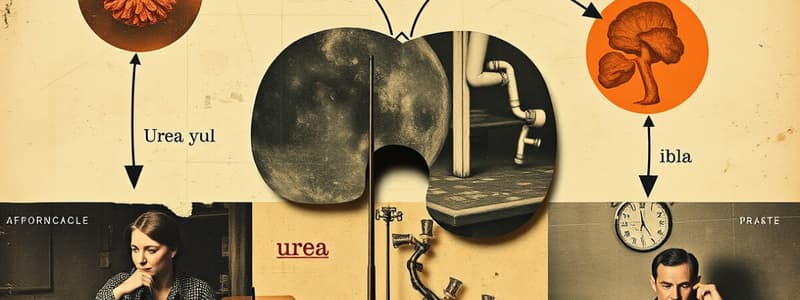Podcast
Questions and Answers
What is the primary nitrogen-containing substance that accounts for 80-90% of the nitrogen excreted in urine?
What is the primary nitrogen-containing substance that accounts for 80-90% of the nitrogen excreted in urine?
- Ammonia
- Creatinine
- Urea (correct)
- Uric acid
Which enzyme catalyzes the first step of urea synthesis, forming carbamoyl phosphate?
Which enzyme catalyzes the first step of urea synthesis, forming carbamoyl phosphate?
- Argininosuccinate synthase
- Arginase
- Carbamoyl phosphate synthase I (correct)
- Ornithine transcarbamylase
Where is urea primarily synthesized in the body?
Where is urea primarily synthesized in the body?
- Pancreas
- Intestines
- Liver (correct)
- Kidneys
What role does ornithine play in the urea cycle?
What role does ornithine play in the urea cycle?
Which molecule provides the carbon atom for urea synthesis?
Which molecule provides the carbon atom for urea synthesis?
What condition is required for carbamoyl phosphate synthase I to function effectively?
What condition is required for carbamoyl phosphate synthase I to function effectively?
In the synthesis of arginosuccinate, what additional molecule is necessary besides citrulline?
In the synthesis of arginosuccinate, what additional molecule is necessary besides citrulline?
What is the final product of the urea cycle?
What is the final product of the urea cycle?
What distinguishes anabolic pathways from catabolic pathways?
What distinguishes anabolic pathways from catabolic pathways?
Which of the following best describes competitive inhibition?
Which of the following best describes competitive inhibition?
What does the Michaelis-Menten constant (Km) indicate about an enzyme?
What does the Michaelis-Menten constant (Km) indicate about an enzyme?
Which factor has an optimal range that, when deviated from, can reduce enzyme activity?
Which factor has an optimal range that, when deviated from, can reduce enzyme activity?
How does feedback inhibition regulate metabolic pathways?
How does feedback inhibition regulate metabolic pathways?
Flashcards are hidden until you start studying
Study Notes
Urea Metabolism Overview
- Urea is the final product of amino acid metabolism, converting toxic ammonia into a non-toxic substance.
- It comprises 80-90% of nitrogenous waste excreted in urine.
- Urea is synthesized in the liver and transported to kidneys for excretion.
Urea Cycle
- Also known as Krebs-Henseleit cycle, named after Hans Krebs and Kurt Henseleit who elucidated it in 1932.
- Individual reactions within the cycle were detailed later by Ratner and Cohen.
- Urea contains two amino (-NH2) groups: one from ammonia (NH3) and the other from aspartate, with carbon provided by carbon dioxide (CO2).
- The cycle involves five distinct enzymes with the first two located in mitochondria and the remaining in the cytosol.
Step 1: Carbamoyl Phosphate Synthesis
- Catalyzed by carbamoyl phosphate synthase I (CPS I) in mitochondria.
- Involves condensation of ammonia ions with CO2 to form carbamoyl phosphate.
- This irreversible step is rate-limiting and consumes two ATP.
- CPS I activity requires N-acetylglutamate.
- A separate enzyme, carbamoyl phosphate synthase II (CPS II), functions in pyrimidine synthesis in the cytosol without needing N-acetylglutamate.
Step 2: Citrulline Formation
- Citrulline is synthesized from carbamoyl phosphate and ornithine by ornithine transcarbamoylase.
- Ornithine is regenerated and re-used in the cycle, similar to oxaloacetate in the citric acid cycle.
- Citrulline, a non-protein amino acid, is transported to the cytosol after formation.
Step 3: Arginosuccinate Synthesis
- Arginosuccinate is produced by the condensation of citrulline and aspartate, facilitated by argininosuccinate synthase.
- This step incorporates the second nitrogen atom into urea and requires ATP, which is split into AMP and pyrophosphate (PPi).
- PPi is quickly broken down into inorganic phosphate (Pi).
Key Concepts
- Urea synthesis is a critical detoxification process involving multiple steps and enzymes.
- The urea cycle plays a vital role in nitrogen metabolism, ensuring the safe elimination of ammonia from the body.
Metabolic Pathways
- Series of chemical reactions within cells converting substrates to products through multiple steps and enzymatic actions.
- Catabolic Pathways: Responsible for breaking down larger molecules to release energy; examples include glycolysis and the citric acid cycle.
- Anabolic Pathways: Function to construct complex molecules from simpler ones, requiring energy input; gluconeogenesis and fatty acid synthesis are key examples.
- ATP: Acts as the primary energy currency in cellular metabolism, facilitating energy transfer.
- Redox Reactions: These involve the transfer of electrons, playing a vital role in energy metabolism and cellular respiration.
- Feedback Inhibition: Mechanism by which the end products of metabolic pathways inhibit earlier phase enzymes to prevent overproduction.
- Pathway Interconnection: Metabolic pathways can share intermediates and regulatory enzymes, allowing for efficient regulation and integration of metabolic processes.
Enzyme Kinetics
- Study focused on the rates of enzyme-catalyzed reactions and how various factors influence these rates.
- Michaelis-Menten Kinetics:
- Vmax: Represents the maximum rate of an enzymatic reaction when the enzyme is saturated with substrate.
- Km: Denotes the substrate concentration at which the reaction rate reaches half of Vmax; serves as an indicator of enzyme affinity for the substrate.
- Michaelis-Menten Equation: V = (Vmax[S]) / (Km + [S]), describing the relationship between reaction velocity, substrate concentration, and enzyme kinetics.
- Enzyme Inhibition Types:
- Competitive Inhibition: Inhibitor competes with a substrate for the active site of the enzyme; increasing substrate levels can overcome this type of inhibition.
- Non-competitive Inhibition: Inhibitor can bind to the enzyme or the enzyme-substrate complex, decreasing overall enzyme activity; this cannot be countered by adding more substrate.
- Uncompetitive Inhibition: Inhibitor binds exclusively to the enzyme-substrate complex, hindering the conversion to product.
- Factors Modifying Enzyme Activity:
- Temperature: Each enzyme has a specific optimal temperature; extreme temperatures can cause denaturation and loss of function.
- pH: Enzymes possess an optimal pH for activity; deviations from this range can lower reaction rates.
- Substrate Concentration: Increasing substrate concentration raises the reaction rate until reaching Vmax, indicating saturation of enzyme active sites.
Studying That Suits You
Use AI to generate personalized quizzes and flashcards to suit your learning preferences.




